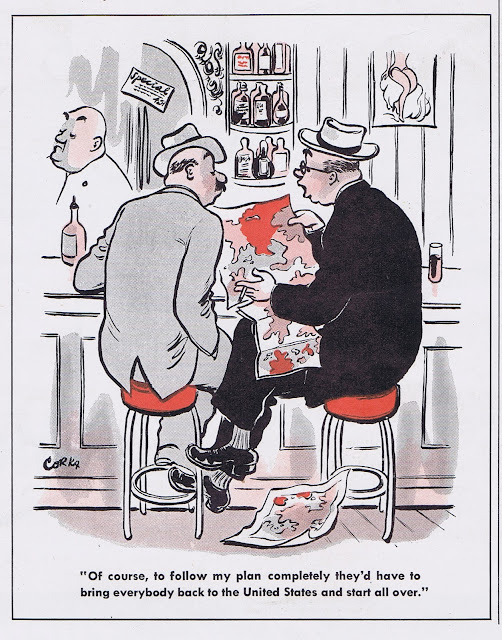---
GAG CARTOONS
From WORLD WAR II
(1943 – 1945)
The second World War was a turning point in world history. In America the consequences were severe. Most men enlisted or were drafted into military service. In order to meet the supply demands of the soldiers fighting on land and sea there were countless shortages which affected every aspect of life on the home front. One of the many areas affected was the humor industry—gag writers and cartoonists enlisted or were drafted, resulting in a drain on talent. Because of the paper shortage, magazines contained far fewer pages than previous issues. Cartoon editors depended on the work of cartoonists not eligible for military service. Several cartoonists somehow managed to submit their work by mail while on active duty.
On the battlefront, humor provided a welcome respite from the reality of War.
One source of news and humor was Yank, a weekly newspaper published by the Army and distributed to soldiers everywhere. Yank was staffed by enlisted men for enlisted men, overseen by a few officers. The interior contained news from back home as well as stories about current military operations. There were cartoons drawn by members of the Yank staff and a 1/3-page Sad Sack cartoon by Sgt George Baker. Each issue also contained a full page of gag cartoons. Some of these were drawn by already established professional cartoonists, and others who would enjoy post-war careers as magazine gag cartoonists. They were joined by numerous amateur G.I. cartoonists.
This sampling of World War II gag cartoons includes both cartoons by home front cartoonists as well as work done by those in combat zones by the Yank staff and G.I contributors . . .
1. GEORGE SHELLHASE. Collier’s 1943.
2. CORKA (Jon Cronin). The Saturday Evening Post April 3, 1943.
3. FRANK BEAVEN. Collier’s September 25, 1943.
4. BARBARA SHERMUND. Collier’s October 23, 1943.
5. MISCHA RICHTER. The iconic “Rosie the Riveter” was the subject of many wartime cartoons. Collier’s June 5, 1943.
6. Cpl. NED HILTON. Collier’s July 31, 1943.
7. Pfc. ERNIE GARZA. Collier’s December, 1943.
8. Sgt. PER RUSE (PETE HANSEN). Hansen was a Disney animator before joining the service. His gag cartoons appeared in Collier’s and The Saturday Evening Post. In the 1950’s he worked on the comic strips Flappadoole and Lolly. Yank April 3, 1945.
9. Cpl. ERNEST MAXWELL. Yank June 1, 1945.
10. Cpl. A. DELATRI. Do we detect a Virgil Partch influence here? Yank June 1, 1945.
11. Pfc. TOM FLANNERY. Flannery became a major market cartoonist in the post-war era. Yank March 25, 1945.
12. RAYMOND F. FISHER. Yank 1944, May 14.
13. Sgt. CHARLES PEARSON. A major market cartoonist before and after the war, he made his first sale to the “old” Life. Yank April 3, 1945.
14.
Cpl. JOHN RUGE. Ruge, a New Yorker cartoonist, appeared more
frequently in Collier’s and The Saturday Evening Post. Yank May 14,
1944.
15. Pfc HANK (HENRY) SYVERSON. Syverson was another Disney animator before the war and a best-selling magazine cartoonist for decades afterwards. He was best known for his long association with The Saturday Evening Post. Yank April 3, 1945.
16. Sgt. TOM ZIBELLI. Also, successful cartoonist after the war who signed his cartoons Zib. Yank April 3, 1945.
17. Pvt. LARRY KATZMAN. Yank April 27, 1945.
18. Sgt. JIM WEEKS. Yank March 25, 1945.
19. Sgt. H. BAUMAN. Yank March 25, 1945.
20. Sgt. GEORGE BAKER. Baker was still another Disney animator who joined the Army. Enlisted men everywhere were absolutely wild about his weekly pantomime panel cartoon Sad Sack. Yank May 4, 1945




























1 comment:
It was something of a revelation to see how Sad Sack originated in WWII. When I was growing up, a very talkative Sad Sack was starring in a line of Harvey comics, molded into a Beetle Bailey clone with a large supporting cast. Covers were signed by Baker, and retained more of his style than the stories inside.
Post a Comment